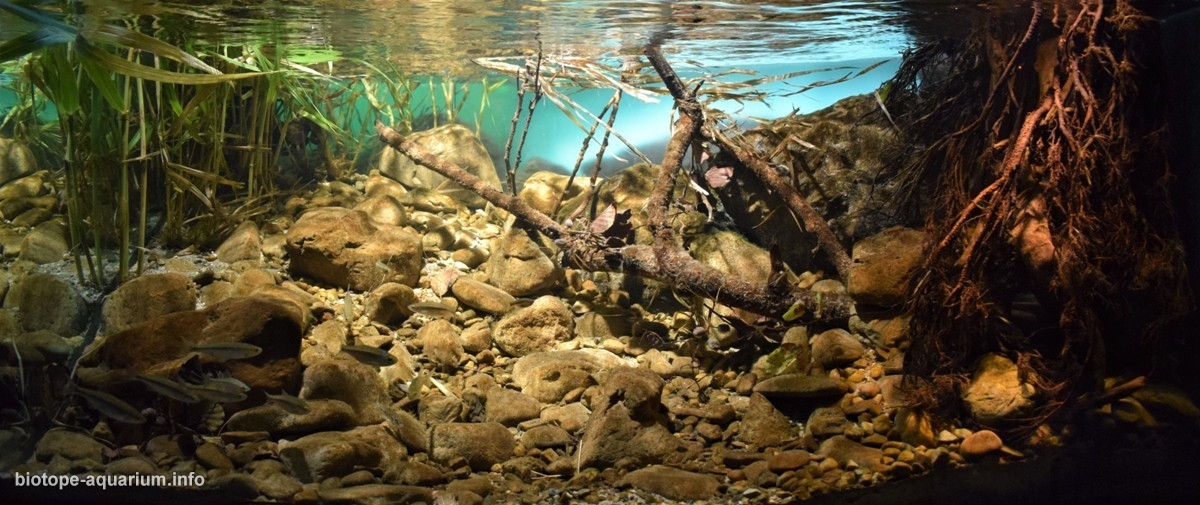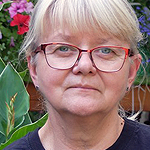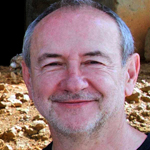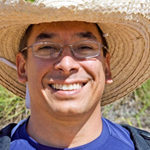Banks of the Zena stream in the Gessi Regional Park San Lazzaro di Savena, Italy
4th place in Biotope Aquarium Design Contest 2019
Poland. Pawel Lukasz Kocik

Volume: 600 L
Dimensions: 600 L corner aquarium, with one side longer 120x65h, 95x65h, front is 100x65h. The aquarium is turned so that the 120 cm long side is a panorama, that is, the front.
List of fishes: Alburnus arborella, Cobitis bilineata, Gobio gobio, Padogobius bonelli, Knipowitschia punctatissima, Pseudorasbora parva
List of plants: Phragmites australis, Alder alnus
Description of decorations: The design of the biotope system has been implemented in a technique that I call “Deep Shadow”, it consists of placing the same elements that are also in the aquarium for a dry tank, stones, roots, reeds as in this biotope, as well as many other elements of soil arrangement. In addition, we can illuminate the background behind the aquarium with RGB LEDs, the bridge that connects the water part with the dry to the unity is a matt adhesive film. Aquarium simulates the beginning of the dry season and presents a stony stream bed located between two banks, on the left we have a reed island, which, like in nature, occurs on a silty or gravel bottom in places directly lit by the sun. There are plenty of crustaceans and algae in the reed habitats (that’s why the background from this site is green) is a great source of fish food. On the right side of the bank we can see the beautiful red alder roots washed out by the stream, which are a refuge for Cobite (caught there) and other small fish species. The stream bed is lined with stones of different sizes, gravel and sand, and at the bottom we can find alder cones so liked by aquarists. In the middle part of the stream there is a broken alder branch and to emphasize the dynamics of the biotope on the photos, in the reed I placed the 8000l / h pump and directed the water current to the sticks, the sediments themselves flow on the branch, giving the traffic biotope. In the dry season, the water is low, but very clean in terms of chemico-physical.All elements used in this aquarium, such as substrate, roots, branch, plants, stones, rocks and cones with fish once were collected from this biotope in nature and documented on the new website ExploreBiotope.com
Description of equipment: Filtration: JBL CristalProfi e1901 greenline – 1900l / h bucket capacity 15l divided into 5 baskets with media, one is a protective sponge, the other four is a biology divided between, Jbl Micromec balls and good quality sintered glass (ceramics).
Water circulation: Jebao DCP-8000l / h electronic pump
Light: The basic lighting is Aquatlantis Easy LED Freshwater, 1047mm, 6800 ° K-52w with EASY LED CONTROL, a simulator of the effects of sunrise and sunset. In addition, a 6000 ° K-16w led lamp, and a small 4000 ° K-10w led lamp, which simulates the sun’s rays piercing through the tree’s crown and illuminating the red alder’s roots. The matte self-adhesive foil was used to make the background, which was additionally illuminated with rgb ledges, on the left side where the reed grows I used a 40cm green rgb strip, it is supposed to simulate algae deep in the reed. The rest of the background is illuminated with rgb LEDs in light blue color which gives the overall depth of water.
Water parameters: Temperature 25°C – PH 7,65 – NO2 0,00mg/l – NO3 10,00mg/l – KH°d 8 – GH°d 17
Additional info: Water changes are 50% every 20 days, the fish are Wild and after catching and moving to the aquarium, they started eating on the second day, now feeding four times a day with JBL AutoFood, the fish get mosquito larvae too.
INFORMATION ABOUT BIOTOPE
Description of the area surrounding the biotope: Zena is a mountain stream of the Central Bologna Apennines in the Gessi Bolognesi Regional Park and Calanchi dell’Abbadessa with its headquarters in San Lazzaro di Savena, which rises in the hills north of the ridge between Loiano and Quinzano 44 ° 15’18.25 “N 11 ° 20 ‘ 26.56 “E / 44 ° 25’50.69” N 11 ° 34’07.11 “E, at an altitude of 750 m above sea level. There are two sources: it is on the west side of the Bastia 792 m.s.lm mountain, and the eastern arm is near Quinzano. This last branch is the main in length and flow of water and creates a beautiful thirty-meter waterfall falling into the forested Quinzano gorge. This area has been documented the existence of hunting communities since the Paleolithic, Bronze Age and just behind the park of the Roman city of Claterna probably of Etruscan origin, developed in Republican times, and especially Augustinians surrounded by the crown of suburban villas, beautiful mosaic floors discovered during excavations are partly preserved today at the Archaeological Museum in Bologna. In the Middle Ages, entire territories were characterized by small villages scattered in the hills, generally fortified and centered around castles or churches. For example, the fortress of San Pietro di Ozzano comes from the inhabitants of Claterna who, after the destruction of the city in the fifth century, took shelter on a nearby hill. Starting from the thirteenth century, the use of baked plaster as a plaster gypsum was developed. The area of the park was affected by systematic chalk excavations, from numerous small quarries at the end of the 19th century, it went into mechanized activity, and then into industrial exploitation, with a great impact on the environment. Many caves were destroyed or their stability was irreversibly disturbed, as in the case of the Farneto cave near the reconstructed biotope. The area of the Park is 3,123 hectares, despite the extreme proximity of the urban area of San Lazzaro di Savena, the park is home to many species of flora and fauna. Zena stream is 40 km long and in its small basin it also receives water from small fields such as Rio di Gnazzano, Rio Laurenzano (main), Rio dei Cani, Rio di Barbarolo, Rio di Caldarano, Rio di Bianchini and Rio dei Vinchi, and then connects with the Idice stream and flows into the river Reno. Ecosystems of park sources and streams are as complex and diverse as onshore. The composition of water and soil are among the main factors determining the presence and distribution of plant and animal species. Transitional zones between the aquatic and terrestrial environments (ecotones, shelters) in which coastal vegetation is located represent the connection between the river and terrestrial ecosystem. There are many animal organisms in such characteristic environments, such as amphibians, reptiles, birds, as well as many mammals, which despite the fact that they do not live exclusively in water, survive thanks to its presence. In the environmental contexts of running waters, as in standing waters, we find vegetation cover characterized by species that exhibit specific and diverse morphological and ecological adaptations in terms of appearance, development and reproduction strategies. The most widespread and characteristic aspect of vegetation, which covers the river bed and streams, is the Salix sp. Willow, mainly made up of species with large shrubs and cuttings. Willows developed the ability to resist the current by implementing a number of adaptive strategies, such as the flexibility of stems and branches. In more calm bends of the river you can meet white willows, black poplar Populus nigra, and sometimes also alder Alnus sp. There are no real aquatic plants in the area (Hydrophytes that carry out the entire vegetative cycle in water). Water vegetation, which grows on wet areas and above all on gravelly or muddy bottoms with low water velocities, is characterized, in relation to the water depth, by habitats dominated by Phragmites australis reeds, typha beetroots Typha angustifolia and Thypa latifolia. In the streams stretching through the park, throughout the year, there are species characteristic of watercourses, such as the kingfisher Alcedo atthis, with characteristic colored plumage that hunts for small fish, diving into water from protruding branches. Along the stream and in the adjacent areas there are also bee eaters Merops apiaster, a small swallow also called the paradise bird. One of the most beautiful birds with a slim silhouette and pointed wings. Another species associated mainly with forested areas with mature trees along watercourses, difficult to observe, but easily detectable in summer thanks to singing, melodious Lio -io is oriolus Oriolus oriolus, whose male has a unique yellow color with black wings. There are many amphibians, reptiles and various species of mammals, such as vole, shrew and skunk, at the Zena stream, these species are closely related to water areas. There are also other species that go to drink or seek shelter. These include foxes, weasels, roe-deer and wild boars. The clear waters of the stream are full of fish. We find here Cobitis bilineata (Canestrini 1865), chub Leuciscus cephalus (Linneo, 1758), roach Chondrostoma genei (Bonaparte, 1839), Gobione europeo Gobio gobio (Linnaeus, 1758), Scazzone Cottus gobio, Cobitis taenia (Linneo, 1758). Cobane mascherato Sabanejevi larvata (De Filippi, 1859), Ghiozzo padano Padogobius bonelli (Bonaparte, 1846), Alburnus arborella (Bonaparte, 1841), trout and many other species, miraculously saved from the bending of Knipowitschia punctatissima and invasive Pseudorasbora parva, Exact coordinates location of the stream biotope is 44 ° 25’50.0 “N 11 ° 23’60.0” E on-site activities such as: water sample taken, temperature, environmental photos and underwater video were taken. The area of the Zena stream (both the valley and the entire pool), with its bucolic appearance, alternating with gentle hills with meadows and forests and some ravines and valleys, scattered buildings and rocky outcrops, has an almost intact nature with almost no production activity and modesty housing estates shows extraordinary natural and historical values.
Description of the underwater landscape of the biotope: The Zena stream is 40 km long and its hydraulic regime is typical for Bologna streams and streams, maximum flow rates are 15 m³ / s during rainstorms, up to 2 m³ / s flow in spring, and average annual flow rates of 1 m³ / s. The transparency of water varies depending on the zones and the amount of rainfall, the summer water is very clean. The average depth of the stream is from 20 cm at the end of August to 150 cm in winter. The stream’s surface consists mainly of various sizes of sandstones and pebbles, and the edges of the trough carved in the area alternate from wooded, overgrown with reeds, which like the sun for habitats, choose the area without trees. Often we can also find invading bamboo colonies, there are no plants in the biotope.
Description of the parameters of the habitat: Summer temperature 22°C/ 29°C – PH 7,88 – NO2 0,00mg/l – NO3 0,00mg/l – KH°d 9 – GH°d 18
List of fishes and invertebrates occurring in the nature biotope: Alburnus arborella (Bonaparte, 1841), Cobitis bilineata (Canestrini 1865), Gobio gobio (Linnaeus, 1758), Padogobius bonelli (Bonaparte, 1846), Knipowitschia punctatissima, Pseudorasbora parva.
Leuciscus cephalus (Linneo, 1758), Chondrostoma genei (Bonaparte, 1839), Cottus gobio, Cobitis taenia (Linneo, 1758). Sabanejewia larvata (De Filippi, 1859)
List of plants found in the nature biotope: Phragmites australis, Typha angustifolia, Thypa latifolia. Tree: Alder alnus roots, branches, leaves and cones were used to decorate the biotope.
Threats to the ecology: In 2013, a detailed report on the water environment of the region was prepared, in which the Zen stream was also described. The whole document is in a PDF file, which I placed in the link, I emphasize that I have never met such a detailed study so far, which took scientists a good few years. The system of standards that regulates the water sector at both European and national levels has radically changed in recent years under the pressure of awareness of the depletion of water resources and is increasingly focused on sustainable development and on one integrated water resource management. The last goal of this EWOLUTION is the 2000/60 / CE Water Directive, which states at the outset that “water is not a commercial product equal to another, but a HERITAGE that must be protected, defended and treated as such” and defines it as “state surface water “general expression determined by the lowest value of ecological status and chemical state, which are combined in the study. The same UNIVERSAL DECLARATION OF HUMAN RIGHTS (article 25) states that WATER is a necessary element to ensure everyone’s universal human right “up to a level sufficient to live and guarantee the health and well-being of their own and their own family.” The main innovative aspect of the new Environmental Status Directive It is achieved by studying the flora and fauna communities that inhabit watercourses, as well as specific contamination of physicochemical elements, etc. There are also problems related to the management of rivers and streams. Controversy in the summer of 2014 Concerning cutting down trees in Savena and on Zena showed lack of knowledge in this delicate and uniform vision of good or bad interventions to be carried out in rivers. Together with climate change, the risk of floods, landslides and total river rains is increasing This is why it is important for this problem to be considered with attention for the future. The carried out research shows that the Zen stream has a very high ecological status and kept all its original values, and this mainly contributed to the survival of species ichthyofauna. Knipowitschia punctatissima (Panzarolo) is a small grandmother with very limited dimensions from 4 to 5 centimeters in length. It occurs endemically in northern Italy, Friuli, Veneto, Lombardy and Emilia Romagna, gender is distinguished by color, males have a spot on the first dorsal fin, in the reproductive period they have a yellow abdominal area. Knipowitschia punctatissima occur in an environment with clean and well-oxygenated water, with medium current, inhabited by stony, sandy and gravel bottoms full of hiding places. Reproduction begins from February to June, where several females can sit in the same nest and wait for the male to fertilize, and continue to look after it for 10 days until hatching. In general, there is no information about the behavior of this small fish, after a monthly observation in the aquarium, I can say that it is a very territorial species. Males share in the areas and in each of them there must be a hideout (nest), fish swim specifically from stone to stone, often stop at the top and observe the surroundings, very spontaneously react to possible aggressors, even two times bigger than themselves. The population is seriously threatened by anthropic pressure so much that IUCN considers it a CRITICAL DANGEROUS (critical risk of total extinction). Extreme pollution, habitat changes, lowering aquifers, urbanization and the basin reduce populations, and if this is not enough, few surviving fish are isolated and cross between themselves (between relatives), the number of specimens is getting smaller and smaller. The main reason is that this species lives in very clean waters, such as springs and streams, in habitats. A few years ago ichthyologists were worried about the fate of this delicate fish. In 2002, because of the strong heat wave and drought, all sources were dry for about 8 months. Panzarolo lives in waters with a temperature of about 15/25 ° C, eight-month drought and high temperatures led the scholars to believe that Panzarolo was extinct. In 2003, no trace of him was found after some research. Then, after one year, they were pleasantly surprised, and Knipowitschia punctatissima was found again. And since 2005 Panzarolo has returned to inhabited sources. How did such a small delicate fish survive? Armando Piccinini and his colleagues have not yet found a definite explanation: the only hypothesis is that they managed to reach some of the underground Roman pipelines that could be in the area where the water remained. It also happens that the Zen stream dries out during the dry season, sometimes a month or two are completely without water, and here the question arises, what about the fish? Species such as Alborella, are known to migrate down the stream as the temperature increases, looking for habitats with deeper water. But what about Gobidae? After all, they are not good swimmers, or maybe the stream has also underground tributaries or flooded caves ex-mines, which we do not lack in the area, we also know that Knipowitschia punctatissima leads the night life and this hypothesis could be probable. I’ve been thinking about it for two months now, but for now, it’s just the opinion of a crazy aquarist and maybe thanks to the presentation of this aquarium, there will be someone specialized who will guess the riddle and prove how it really is.
Sources of information:
https://www.explorebiotope.
https://www.arpae.it/cms3/
https://www.arpae.it/cms3/
http://www.
https://it.wikipedia.org/wiki/
http://www.
https://www.
https://www.bolognawelcome.
http://www.parks.it/parco.
http://www.iucn.it/scheda.php?
https://ricerca.gelocal.it/
https://www.arpae.it/cms3/
http://www.ittiofauna.org/
http://www.ittiofauna.org/
https://ambiente.regione.
http://www.ittiofauna.org/
https://ambiente.regione.
http://www.ittiofauna.org/
https://adminchiam.com/
https://it.wikipedia.org/wiki/
http://www.ittiofauna.org/
Comments of the members of the jury of Biotope Aquarium Design Contest 2019

This is a captivating layout with an outstanding use of the available space. The concealment of the Jebao flow pump was a masterstroke, providing just the long laminar current along the front glass these fish crave so. In the videos it’s clear that they’re taking advantage of it, exhibiting the exact type of behaviour I’d expect in fishes from a fluviatile habitat. In particular I like the use of the shaped bank that acts like a hydrological scoop, channelling exhausted water back up and into the flow pump once more.

Perfect example of natural looking tank, looks like I’m swimming in this river. Natural light, perfect setup. For me one with the best natural tank. Congratulation for so nice video, and climate of the arrangement. I love this natural aquarium.

The setting represents a bed of a small creek in an excellent way, beautifully built.

It is a great aquarium in every way. At first, I even thought that the video was shot in nature. The decorations are placed properly; European fishes are rare for the contest. This work left pleasant feeling. I would only recommend installing the filter / pump correctly. You placed it on the side (although the river is in section) and fishes (in nature they swim against the stream) in the video float across the stream, which is unacceptable in nature.

This aquarium drew my attention because of its magnificent lighting. The setup was brilliant, making me feel like I was swimming in the stream. The dancing light reflections mixed with dark areas in the aquarium create an ever-changing visual game that looks pleasing and somewhat hypnotizing. The rocks had the perfect amount of detritus on it and the sand matched the rocks flawlessly. All the fish seem to blend in with the substrate as well, creating that natural aquarium look.

It is an excellent work. The arrangement of the stones gives us a very good impression of depth and naturalness, where we can clearly see the margin of the body of water and its continuity marking different portions of the same body of water. Well done! Congratulations!

This vibrant, sunlit scene from an Italian river evokes a sense of wild spontaneity. Employing a slope from front to back combined with a stand of reeds and a blue, hazy background erases the boundaries of the tank and creates an illusion of great depth. The well-considered arrangement of different sizes of worn river stones exactly replicates the natural appearance of a river bed, accentuated by the rippling effect of the light playing over the bottom. Scattered branches festooned with streamers of decaying reeds swaying in the current, the fuzz of algae and biofilm on the branches and rocks, and the overhanging tangle of tree roots at the bank all add to the authenticity of the biotope. The instinctual behavior of the inhabitants is clearly expressed as each finds its niche; schooling fish in the deepest section with the strongest flow, bottom-dwellers perching on the stones and among the roots, displaying. All the fish seem healthy and active due to the faithful replication of their respective microhabitats.

This was one of my favorite tanks of the contest. Visually this was very attractive. An extremely accurate and interesting description. You used interesting local fish in a well thought combination. You collected the design elements in the river and placed them strategically in the tank, so the fish could hide. Besides that you used a decent flow in this system, which is needed fort he species. 10/10! Congratulations!
